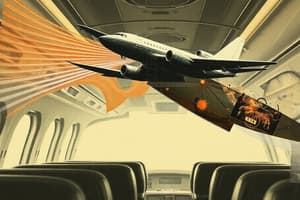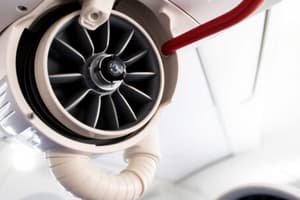Podcast
Questions and Answers
What is the purpose of the discharge valve in a cabin air supply system?
What is the purpose of the discharge valve in a cabin air supply system?
- To prevent the cabin from being over-pressurized
- To open when the maximum cabin pressure differential is reached (correct)
- To close when the maximum cabin pressure differential is reached
- To regulate the flow of air into the cabin
What is the purpose of a 'spill' valve in a cabin air supply system?
What is the purpose of a 'spill' valve in a cabin air supply system?
- To relieve pressure in the air supply ducting
- To provide heating to the cabin
- To release excess air delivered at sea level and lower altitudes (correct)
- To regulate the flow of air into the cabin
Should you operate the flying controls during a cabin pressure ground test?
Should you operate the flying controls during a cabin pressure ground test?
- It depends on the aircraft type and test requirements
- No, the controls should remain stationary
- Only occasionally, when instructed by the test procedure
- Yes, it is necessary to test the controls (correct)
Which component must be isolated when carrying out a ground cabin pressure test?
Which component must be isolated when carrying out a ground cabin pressure test?
What position is the inward relief valve spring loaded to?
What position is the inward relief valve spring loaded to?
What is the most desirable location for a cabin pressure air leak from the fuselage?
What is the most desirable location for a cabin pressure air leak from the fuselage?
During a normal climb from aerodrome level with the pressurization system 'ON', what happens to the cabin differential pressure?
During a normal climb from aerodrome level with the pressurization system 'ON', what happens to the cabin differential pressure?
At what cabin differential pressure is the inward relief valve usually set to operate?
At what cabin differential pressure is the inward relief valve usually set to operate?
What should the humidity within a passenger cabin be?
What should the humidity within a passenger cabin be?
One of the principles of cooling employed in an air cycle system is the:
One of the principles of cooling employed in an air cycle system is the:
Who selects the rate of change of cabin pressure?
Who selects the rate of change of cabin pressure?
If an aircraft has a maximum differential pressure of 8.5 PSI at cruising altitude and the ambient pressure is 2.9 PSI, what would the pressure inside the cabin be at cruising altitude?
If an aircraft has a maximum differential pressure of 8.5 PSI at cruising altitude and the ambient pressure is 2.9 PSI, what would the pressure inside the cabin be at cruising altitude?
What should be done before filling a vapour cycle cooling system?
What should be done before filling a vapour cycle cooling system?
What determines the cabin differential?
What determines the cabin differential?
What is the minimum rate of flow of air from the punkha louvers?
What is the minimum rate of flow of air from the punkha louvers?
Why is an aircraft cabin air conditioned and pressurized?
Why is an aircraft cabin air conditioned and pressurized?
What is the minimum required humidity level for the ventilation air in the aircraft cabin?
What is the minimum required humidity level for the ventilation air in the aircraft cabin?
In a Boot-Strap Air Conditioning supply system, the source of compressed air comes from:
In a Boot-Strap Air Conditioning supply system, the source of compressed air comes from:
The typical temperature range maintained within the aircraft cabin is:
The typical temperature range maintained within the aircraft cabin is:
In a Bleed Air air-conditioning system, the warm air supply is provided by:
In a Bleed Air air-conditioning system, the warm air supply is provided by:
The cabin altitude refers to:
The cabin altitude refers to:
The cabin differential pressure is defined as:
The cabin differential pressure is defined as:
The outflow of air from the cabin is regulated by:
The outflow of air from the cabin is regulated by:
When air is pressurized, the oxygen content:
When air is pressurized, the oxygen content:
Cabin pressure differential is the difference between:
Cabin pressure differential is the difference between:
In a 'bootstrap' cooling system, the supply of air is first:
In a 'bootstrap' cooling system, the supply of air is first:
What is the purpose of a 'muff' or air ducting around the engine exhaust system?
What is the purpose of a 'muff' or air ducting around the engine exhaust system?
Why are inward relief valves interconnected in pressurized aircraft?
Why are inward relief valves interconnected in pressurized aircraft?
In a turbo fan cold air system, where does the heat exchanger cooling air come from?
In a turbo fan cold air system, where does the heat exchanger cooling air come from?
At what pressure will a safety valve normally relieve compared to a discharge valve?
At what pressure will a safety valve normally relieve compared to a discharge valve?
What does 'conditioned air' refer to?
What does 'conditioned air' refer to?
What is the principle of cabin pressurization?
What is the principle of cabin pressurization?
When the cabin differential pressure has reached the required value and height is maintained, what happens?
When the cabin differential pressure has reached the required value and height is maintained, what happens?
What is the function of the mass airflow control valve?
What is the function of the mass airflow control valve?
How does the cabin pressure controller maintain a pre-set cabin altitude?
How does the cabin pressure controller maintain a pre-set cabin altitude?
If the cabin height is set lower than airfield height on the ground with squat switches overridden, what will the outflow valve normally do?
If the cabin height is set lower than airfield height on the ground with squat switches overridden, what will the outflow valve normally do?
What should the rate of change of pressure be during descent to avoid discomfort?
What should the rate of change of pressure be during descent to avoid discomfort?
In a vapour cycle cooling system, how is heat removed from the charge air?
In a vapour cycle cooling system, how is heat removed from the charge air?
When will an inward relief valve operate in an aircraft?
When will an inward relief valve operate in an aircraft?
At 40,000 ft, what does pressurization ensure regarding cabin pressure?
At 40,000 ft, what does pressurization ensure regarding cabin pressure?
What does the pressure controller activate in an aircraft?
What does the pressure controller activate in an aircraft?
Why might the flight altitude set on the pressurization control panel be 500 ft more than the actual flight altitude during cruising near the operational ceiling?
Why might the flight altitude set on the pressurization control panel be 500 ft more than the actual flight altitude during cruising near the operational ceiling?
How is the cabin rate of climb displayed in an aircraft?
How is the cabin rate of climb displayed in an aircraft?
Why would a water separator be installed in a pressurization system?
Why would a water separator be installed in a pressurization system?
Where does the supply air flow to after passing through the primary heat exchanger in a turbo-fan cold air system?
Where does the supply air flow to after passing through the primary heat exchanger in a turbo-fan cold air system?
How is the heat exchanger in a turbo-fan system cooled?
How is the heat exchanger in a turbo-fan system cooled?
What forces would cause the aircraft to explode due to internal pressure?
What forces would cause the aircraft to explode due to internal pressure?
In most pressurization systems, what is the amount of compressed air delivered to the cabin?
In most pressurization systems, what is the amount of compressed air delivered to the cabin?
What happens when dissipating heat in a vapor cycle system?
What happens when dissipating heat in a vapor cycle system?
What are the international markings for air conditioning pipelines?
What are the international markings for air conditioning pipelines?
How does a cabin pressure controller maintain a particular cabin altitude?
How does a cabin pressure controller maintain a particular cabin altitude?
When is a cabin humidifier operated?
When is a cabin humidifier operated?
In an air conditioning system, how is heat added to the air?
In an air conditioning system, how is heat added to the air?
Flashcards are hidden until you start studying
Study Notes
Cabin Pressurization and Air Conditioning
Cabin Pressurization
- During a normal climb with the pressurization system 'ON', the atmospheric pressure decreases more quickly than the cabin pressure.
- Cabin differential pressure is maintained by controlling the rate of change of cabin pressure.
- The cabin pressure is determined by the selected cabin height and the actual aircraft altitude.
Inward Relief Valve
- The inward relief valve is set to operate at a cabin differential of -0.5 PSI.
- The valve operates when the cabin pressure is lower than the ambient pressure.
- The valve ensures that the pressure hull of an aircraft is not subjected to a negative differential pressure.
Cabin Air Conditioning
- The humidity within a passenger cabin should be between 30% and 70%.
- The temperature within the cabin is normally maintained at 18°C to 24°C.
- Air conditioning systems use various methods to cool the air, including vapor cycle cooling and air cycle cooling.
Air Cycle Cooling System
- One of the principles of cooling employed in an air cycle system is the conversion of heat energy to mechanical energy in the C.A.U.
- The system uses a turbine to cool the air, which is then expanded to reduce its temperature.
Cabin Pressure Control
- The rate of change of cabin pressure is selected by the pilot and controlled by the pressure controller.
- The cabin pressure controller maintains a pre-set cabin altitude by regulating the position of the outflow valve.
- The pressure controller activates the cabin discharge valve to control the cabin pressure.
Safety Features
- A safety valve will normally relieve at a higher differential pressure than the discharge valve.
- The outflow valve ensures that the cabin pressure does not exceed the maximum differential pressure.
Air Conditioning Systems
- There are different types of air conditioning systems, including bootstrap and bleed air systems.
- Bootstrap systems use a compressor to compress the air, which is then cooled and expanded to reduce its temperature.
- Bleed air systems use air bled from the engine compressor to cool the air.
Vapour Cycle Cooling System
- Heat is removed from the charge air by changing a liquid into a vapour.
- The system uses a heat exchanger to cool the air, which is then condensed and evaporated to reduce its temperature.
Pressurization System Components
- A spill valve is used to spill overboard excess air delivered at sea level and lower altitudes.
- A discharge valve is used to relieve the pressure in the air supply ducting to atmosphere.
- A silencer is used to reduce the noise from the blowers and/or compressors in the system.
Tests and Procedures
-
Before filling a vapour cycle cooling system, the system should be applied suction to remove air and moisture.
-
When carrying out a ground pressure test, the aircraft engines should be used to test the whole system.
-
The pressure controller should be set to a lower altitude than the actual aircraft altitude to prevent the pressure controller from hunting.### Aircraft Pressurization and Air Conditioning
-
A high negative differential pressure can cause the aircraft to explode.
-
In most pressurization systems, the amount of compressed air delivered to the cabin is reasonably constant, regardless of altitude.
Vapour Cycle System
- When dissipating heat in a vapour cycle system, vapour converts to a liquid.
International Markings
- International markings for air conditioning pipelines are denoted by dots.
Cabin Pressure Control
- The cabin pressure controller maintains a particular cabin altitude by controlling the outflow valve position.
Cabin Humidification
- A cabin humidifier is operated at high altitudes.
Air Conditioning System
- Heat is added to the air in an air conditioning system by restricting the compressor outlet.
Ditching Control
- Ditching control is used for closing all valves and inlets.
Mass Flow Controller
- The purpose of a mass flow controller is to ensure that a constant mass of air is delivered to the cabin at all times.
Safety Features
- Failure of the normal maximum differential pressure control is catered for by cabin safety relief valves.
Turbo Fan CAU
- A turbo fan CAU used for air cycle cooling decreases the pressure and temperature of the charge air.
Flight Deck Air Requirements
- The Flight Deck requires 10 cubic feet/minute of air.
Studying That Suits You
Use AI to generate personalized quizzes and flashcards to suit your learning preferences.



